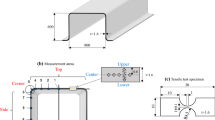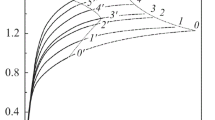Abstract
The purpose of this paper is to investigate the influence of residual stresses, due to cold-drawing, on the hydrogen embrittlement susceptibility of pearlitic wires used for prestressing concrete. Surface residual stresses were measured by X-ray diffraction and a 3D finite element model was used to simulate the drawing process. Hydrogen susceptibility was evaluated through rupture times in NH4SCN tests. The presence of residual stresses may help in explaining the scatter in times to rupture, the disappearance of a stress threshold, the differences in times to rupture of steel wires with the same microstructure, surface quality and mechanical properties, or the saturation in rupture time above certain values of the testing load.
Résumé
Le but de cet article est l'analyse de l'influence des contraintes résiduelles, produites par le tréfilage, sur la sensibilité à la fragilisation par l'hydrogène des câbles d'acier perlitiques utilisés pour le béton précontraint. Les contraintes résiduelles en surface ont été mesurées par diffraction des rayons X et le processus de tréfilage a été simulé avec un code d'éléments finis en 3D. La présence des tensions résiduelles peut aider à expliquer la dispersion des temps de rupture, la disparition d'un seuil de contrainte, les différents temps de rupture des câbles en acier avec la même microstructure, qualité superficielle et propriétés mécaniques, ou même la saturation du temps de rupture en dessous de certaines valuers de la charge de l'essai.
Similar content being viewed by others
References
CUR, ‘Cases of damage to corrosion of prestressing steel’, Netherlands Committee for Concrete Research, Report n049 (1971).
Phillips, E., ‘Survey of corrosion of prestressing concrete water-retaining structures’, Australian Water Resources Coucil, Paper n09 (1975).
Nürnberger, U., ‘Research: Road Construction and its Techniques’, H. 308 (1981) 1–195 [in German].
Bijl, C., Lamers, L. and Wind, G. (Eds.), ‘Stress Corrosion of Prestressing Steel’, Proceedings 1st FIP Symposium (Koninklijke Nederlandsche Hoogoverns, Holland, 1971).
Blekkenhorst, F., Lamers, L. and Wind, G. (Eds.), ‘Stress Corrosion of Prestressing Steel’, Proceedings 2nd FIP Symposium (Hoogoverns, Ijmuiden, Holland, 1973).
Elices, M. and Sánchez-Gálvez, V. (Eds.), ‘Stress Corrosion of Prestressing Steel’, Proceeding 3rd FIP Symposium (FIP-Berkeley, Wexham Springs Slough, UK, 1981).
Enos, D.G. and Scully, J.R., ‘A critical-strain criterion for hydrogen embrittlement of cold-drawn, ultrafine pearlitic steel’,Metallurgical and Materials Transactions A 33 (2002) 1151–1166.
FIP-78 (Stress Corrosion Test), ‘Stress corrosion cracking resistence test for prestressing tendons’, Technical Report n0 5 (FIP, Wexham Springs, Slough, UK, 1978).
Parkins, R. N., Elices, M. and Sánchez-Gálvez, V., ‘Some comments on the standardization of test methods for prestressing steel’, in Stress Corrosion of Prestressing Steel, (M. Elices and V. Sánchez Gálvez, Eds., 1981).
Elices, M., Sánchez-Gálvez, V., Bernstein, I. and Parkins, R.N., ‘Summary of a meeting of stress corrosion cracking and hydrogen embrittlement of steels for prestressing concrete’, in Hydrogen Problems in Steel, (C.G. Interrante and G.M. Pressouyre Eds.), ASM (1982) 304–307.
Elices, M., Maeder, G. and Sánchez-Gálvez, V., ‘Effect of surface residual stress on hydrogen embrittlement of prestressing steels’,British Corrosion Journal 18(2) (1983).
Sánchez-Gálvez, V. and Elices, M., ‘On hydrogen induced cracking in prestressing steels wires’, in ‘Life Assessment of Dynamically Loaded Materials and Structures’ (L. Faria, Ed., Vol. 2, 1984) 1003–1014.
Atienza, J.M., Martínez, M., Mompeán, F.J., García-Hernández, M., Ruiz, J. and Elices, M., ‘Residual stresses in wires: Numerical and experimental approach’, in ECF 14: Fracture Mechanics beyond 2000, Vol. 1 (A. Neimitz et al. Eds.), EMAS Publishing (2002) 113–120.
Atienza, J.M., ‘Residual stresses in drawn steel wires’, PhD. Thesis (Polytechnique University of Madrid), 2001.
Atienza, J.M., Elices, M., Ruiz, J., Martínez, M., García-Hernández, M. and Mompeán, F.J., ‘Residual stresses, due to cold-drawing, in ferritic and pearlitic wires’ (Submitted toJ. Materials Research).
Van Acker, K., Root, J., van Houtte, P. and Aernoudt, E., ‘Neutron diffraction measurement of the residual stress in the cementite and ferrite phases of cold-drawn steel wires’,Acta Mater. 44 (1996) 4039–4049.
Atienza, J.M. and Elices M., ‘Influence of residual stresses in the tensile test of cold drawn wires’,Mater. Struct. 36 (2003) 548–552.
ISO/DIS 15630.3, ‘Steel for the reinforcement and prestressing of concrete. Test methods. Part 3: Prestressing steel’, Section 10.
Author information
Authors and Affiliations
Additional information
Editorial note Prof. Manuel Elices is a RILEM Senior Member.
Rights and permissions
About this article
Cite this article
Elices, M., Ruiz, J. & Atienza, J.M. Influence of residual stresses on hydrogen embrittlement of cold drawn wires. Mat. Struct. 37, 305–310 (2004). https://doi.org/10.1007/BF02481676
Received:
Accepted:
Issue Date:
DOI: https://doi.org/10.1007/BF02481676




